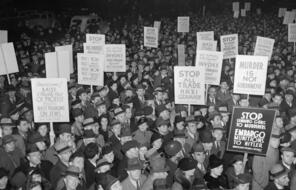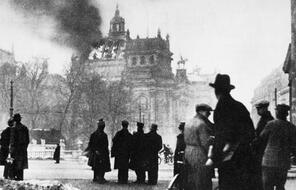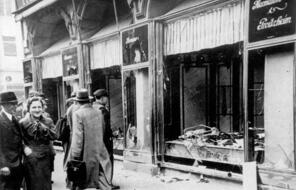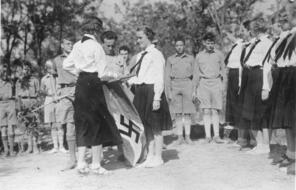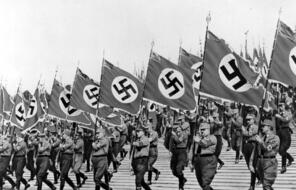Dividing Poland and Its People
Subject
- History
Language
English — USUpdated
Hitler's Ideology: Race, Land, and Conquest
When the Germans invaded and then occupied Poland in September 1939, they did not take over the entire country. They honored a secret clause in a pact they had signed with the Soviet Union on August 23, 1939, a little over a week before the invasion (see reading, A Pact with the Soviet Union in Chapter 7). The pact gave eastern Poland to the Soviet Union, and on September 17, the Soviets took over that territory. In June 1940, they moved on to the Baltic States—Lithuania, Latvia, and Estonia.
From the start, Hitler made no secret of how he felt about the people of Poland. He considered Poles, the ethnic majority in Poland, to be “sub-human.” Alfred Rosenberg, a leading proponent of Nazi ideology, summed up a conversation he had with Hitler in a diary entry dated September 1939:
The Poles: a thin Germanic layer, underneath frightful material. The Jews, the most appalling people one can imagine. The towns thick with dirt. He’s [Hitler] learned a lot in these past weeks. Above all, if Poland had gone on ruling the old German parts for a few more decades everything would have become lice-ridden and decayed. What was needed now was a determined and masterful hand to rule. 1
Soon after the invasion, Germany divided its portion of Poland into two parts: the Warthegau, which bordered Germany, and the General Government of Poland, which consisted of the rest of Germany’s portion of the country. The Warthegau was annexed into Germany itself; the General Government was treated like a colony and placed under the control of Hans Frank, one of Hitler’s chief advisors. To “Aryanize” the Warthegau, the Nazis expelled hundreds of thousands of Poles, Jews, and Sinti and Roma from that territory to the General Government.
In Hitler’s view, the only “racially valuable” inhabitants of Poland were the so-called “ethnic Germans”—those of German descent. To underscore that idea, the Germans established rules and regulations designed to make the Poles and other “undesirable groups” in Poland (both in the Warthegau and the General Government) understand “that they are the conquered and we are the conquerors and those who act against . . . regulations, expose themselves to the most severe punishment.” As a result, Poles were required to “leave the pavement free” for their conquerors (and walk in the street or gutter); they had to serve Germans first in shops; and they were to tip their hats to “important personalities of State, Party and armed forces”—but they were not allowed to say “Heil Hitler!” That greeting was to be used only by Germans. 2
Educated Poles were now subject to arbitrary arrest. In early November 1939, the Nazis shipped 167 professors from Kraków University to Sachsenhausen, a concentration camp outside Berlin. Later that week, they arrested a thousand Polish intellectuals. In December, Hitler issued a special decree that said that anyone considered a threat to German security could “vanish without a trace into the night and fog.” 3
On October 7, 1939, Hitler had appointed Heinrich Himmler, the head of the SS, to a new position—Reich Commissioner for the Strengthening of Germandom. Seven months later, Himmler wrote:
The non-German population of the eastern territories [areas of Poland conquered by Germany] must not receive any education higher than that of an elementary school with four [grades]. The objective of this schooling must simply be to teach: simple arithmetic up to 500 at the most, how to write one’s name; and to teach that it is God’s commandment to be obedient to the Germans and to be honest, hard working and well-behaved. I consider it unnecessary to teach reading. . . .
Parents who wish to provide their children with a better education both in the elementary school and later in a secondary school, must make an application to the Higher SS and Police Leader. . . . If we recognize such a child as being of our blood, then the parents will be informed that the child will be placed in a school in Germany and will remain in Germany indefinitely . . .
The parents of these children of good blood will be given the choice of either giving up their child . . . or they would have to agree to go to Germany and become loyal citizens there. 4
Following these directives, the Nazis shipped about 200,000 “racially valuable” children to Germany to be turned into “true Aryans.” The boys were trained as soldiers and the girls for motherhood.
Connection Questions
- What were the Nazis’ plans for Poland? How did they divide the country and its people?
- How did Poles fit into the Nazis’ beliefs about a racial hierarchy?
- After the German invasion of Poland, what did the Nazis do to show Poles that “they are the conquered and we are the conquerors”? Why did the Nazis believe this was important?
- What is the significance of Himmler’s title, “Reich Commissioner for the Strengthening of Germandom”?
- Why would the Nazis specifically target educated Poles and Polish intellectuals? Why would they restrict access to education? What does this suggest about the power of education?
- 1Quoted in Jeremy Noakes and Geoffrey Pridham, eds., Nazism: A History in Documents and Eyewitness Accounts, 1919–1945, vol. 2 (New York: Schocken Books, 1988), 927.
- 2Martin Gilbert, A History of the Twentieth Century (London: HarperCollins, 1997), 282.
- 3Martin Gilbert, A History of the Twentieth Century (London: HarperCollins, 1997), 287.
- 4Quoted in Jeremy Noakes and Geoffrey Pridham, eds., Nazism: A History in Documents and Eyewitness Accounts, 1919–1945, vol. 2 (New York: Schocken Books, 1988), 933.
How to Cite This Reading
Facing History & Ourselves, “Dividing Poland and Its People”, last updated August 2, 2016.

